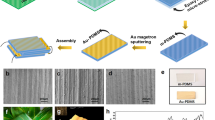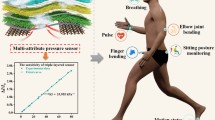Abstract
The human skin has the ability to sense tactile touch and a great range of pressures. Therefore, in prosthetic or robotic systems, it is necessary to prepare pressure sensors with high sensitivity in a wide measurement range to provide human-like tactile sensation. Herein, we developed a flexible piezoresistive pressure sensor that is highly sensitive in a broad pressure range by using lotus leaf micropatterned polydimethylsiloxane and multilayer superposition. By superposing four layers of micropatterned constructive substrates, the multilayer piezoresistive pressure sensor achieves a broad pressure range of 312 kPa, a high sensitivity of 2.525 kPa−1, a low limit of detection (LOD) of <12 Pa, and a fast response time of 45 ms. Compared with the traditional flexible pressure sensor, the pressure range of this sensor can be increased by at least an order of magnitude. The flexible piezoresistive pressure sensor also shows high robustness: after testing for at least 1000 cycles, it shows no sign of fatigue. More importantly, these sensors can be potentially applied in various human motion detection scenarios, including tiny pulse monitoring, throat vibration detection, and large under-feet pressure sensing. The proposed fabrication strategy may guide the design of other kinds of multifunctional sensors to improve the detection performance.
Graphic abstract






Similar content being viewed by others
References
Zhan Z, Lin R, Tran VT et al (2017) Paper/carbon nanotube-based wearable pressure sensor for physiological signal acquisition and soft robotic skin. ACS Appl Mater Interfaces 9(43):37921–37928. https://doi.org/10.1021/acsami.7b10820
Boutry CM, Negre M, Jorda M et al (2018) A hierarchically patterned, bioinspirede-skin able to detect the direction of applied pressure for robotics. Sci Robot 3(24):eaau6914. https://doi.org/10.1126/scirobotics.aau6914
Bermúdez GSC, Fuchs H, Bischoff L et al (2018) Electronic-skin compasses for geomagnetic field-driven artificial magnetoreception and interactive electronics. Nat Electron 1:589–595. https://doi.org/10.1038/s41928-018-0161-6
Wang C, Wang DH, Yu Z et al (2013) User-interactive electronic skin for instantaneous pressure visualization. Nat Mater 12:899–904. https://doi.org/10.1038/nmat3711
Wang XW, Gu Y, Xiong ZP et al (2014) Silk-molded flexible, ultrasensitive, and highly stable electronic skin for monitoring human physiological signals. Adv Mater 26(9):1336–1342. https://doi.org/10.1002/adma.201304248
Qi K, He JX, Wang HB et al (2017) A highly stretchable nanofiber-based electronicskin with pressure-, strain-, and flexion-sensitive properties for health and motion monitoring. ACS Appl Mater Interfaces 9(49):42951–42960. https://doi.org/10.1021/acsami.7b07935
Mannsfeld SCB, Tee BCK, Stoltenberg RM et al (2010) Highly sensitive flexible pressure sensors with microstructured rubber dielectric layers. Nat Mater 9:859–864. https://doi.org/10.1038/nmat2834
Hammock ML, Chortos A, Tee BCK et al (2013) 25th anniversary article: the evolution of electronic skin (e-skin): a brief history, design considerations, and recent progress. Adv Mater 25(42):5997–6038. https://doi.org/10.1002/adma.201302240
Wang Y, Wang L, Yang T et al (2014) Wearable and highly sensitive graphene strain sensors for human motion monitoring. Adv Funct Mater 24(29):4666–4670. https://doi.org/10.1002/adfm.201400379
Roh E, Hwang BU, Kim D et al (2015) Stretchable, transparent, ultrasensitive, and patchable strain sensor for human–machine interfaces comprising a nanohybrid of carbon nanotubes and conductive elastomers. ACS Nano 9(6):6252–6261. https://doi.org/10.1021/acsnano.5b01613
Zhang Y, Hu Y, Zhu P et al (2017) A flexible and highly sensitive pressure sensor based on microdome-patterned PDMS forming with assistance of colloid self-assembly and replica technique for wearable electronics. ACS Appl Mater Interfaces 9(41):35968–35976. https://doi.org/10.1021/acsami.7b09617
Park H, Jeong YR, Yun J et al (2015) Stretchable array of highly sensitive pressure sensors consisting of polyaniline nanofibers and Au-coated polydimethylsiloxane micropillars. ACS Nano 9(10):9974–9985. https://doi.org/10.1021/acsnano.5b03510
Zhu B, Niu Z, Wang H et al (2014) Microstructured graphene arrays for highly sensitive flexible tactile sensors. Small 10(18):3625–3631. https://doi.org/10.1002/smll.201401207
Tsai Y, Wang C, Chang T et al (2019) Multilayered Ag NPs-PEDOT-paper composite device for human-machine interfacing. ACS Appl Mater Interfaces 11(10):10380–10388. https://doi.org/10.1021/acsami.8b21390
Shuai X, Zhu P, Zeng W et al (2017) Highly sensitive flexible pressure sensor based on silver nanowires-embedded polydimethylsiloxane electrode with microarray structure. ACS Appl Mater Interfaces 9(31):26314–26324. https://doi.org/10.1021/acsami.7b05753
Kim JH, Caprioli J (2018) Intraocular pressure fluctuation: is it important? J Ophthalmic Vis Res 13:170
Choong CL, Shim MB, Lee BS et al (2014) Highly stretchable resistive pressure sensors using a conductive elastomeric composite on a micropyramid array. Adv Mater 26(21):3451–3458. https://doi.org/10.1002/adma.201305182
Li Z, Wang ZL (2011) Air/liquid-pressure and heartbeat-driven flexible fiber nanogenerators as a micro/nano-power source or diagnostic sensor. Adv Mater 23(1):84–89. https://doi.org/10.1002/adma.201003161
Lou C, Wang S, Liang T et al (2017) A graphene-based flexible pressure sensor with applications to plantar pressure measurement and gait analysis. Materials 10(9):1068. https://doi.org/10.3390/ma10091068
Kwon D, Lee TI, Shim J et al (2016) Highly sensitive, flexible, and wearable pressure sensor based on a giant piezocapacitive effect of three-dimensional microporous elastomeric dielectric layer. ACS Appl Mater Interfaces 8(26):16922–16931. https://doi.org/10.1021/acsami.6b04225
Ruth SRA, Beker L, Tran H et al (2019) Rational design of capacitive pressure sensors based on pyramidal microstructures for specialized monitoring of biosignals. Adv Funct Mater 30(29):1903100. https://doi.org/10.1002/adfm.201903100
Park J, Kim J, Hong J et al (2018) Tailoring force sensitivity and selectivity by microstructure engineering of multidirectional electronic skins. NPG Asia Mater 10:163–176. https://doi.org/10.1038/s41427-018-0031-8
Santos A, Pinela N, Alves P et al (2018) Piezoresistive e-skin sensors produced with laser engraved molds. Adv Electron Mater 4(9):1800182. https://doi.org/10.1002/aelm.201800182
Chen M, Li K, Cheng G et al (2019) Touchpoint-tailored ultrasensitive piezoresistive pressure sensors with a broad dynamic response range and low detection limit. ACS Appl Mater Interfaces 11(2):2551–2558. https://doi.org/10.1021/acsami.8b20284
Shi J, Liu W, Dai Z et al (2018) Multiscale hierarchical design of a flexible piezoresistive pressure sensor with high sensitivity and wide linearity range. Small 14(27):1800819. https://doi.org/10.1002/smll.201800819
Zhong W, Liu C, Liu Q et al (2018) Ultrasensitive wearable pressure sensors assembled by surface-patterned polyolefin elastomer nanofiber membrane interpenetrated with silver nanowires. ACS Appl Mater Interfaces 10(49):42706–42714. https://doi.org/10.1021/acsami.8b12363
Benjamin CKT, Chortos A, Dunn RR et al (2014) Tunable flexible pressure sensors using microstructured elastomer geometries for intuitive electronics. Adv Funct Mater 24(34):5427–5434. https://doi.org/10.1002/adfm.201400712
Gao Y, Lu C, Yu G et al (2019) Laser micro-structured pressure sensor with modulated sensitivity for electronic skins. Nanotechnology 30(32):325502. https://doi.org/10.1088/1361-6528/ab1a86
Zhao X, Hua Q, Yu R et al (2015) Flexible, stretchable and wearable multifunctional sensor array as artificial electronic skin for static and dynamic strain mapping. Adv Electron Mater 1(7):1500142. https://doi.org/10.1002/aelm.201500142
Wei Y, Chen S, Lin Y et al (2015) Cu–Ag core–shell nanowires for electronic skin with a petal molded microstructure. J Mater Chem C 3:9594–9602. https://doi.org/10.1039/C5TC01723H
Yao HB, Ge J, Wang CF et al (2013) A flexible and highly pressure-sensitive graphene–polyurethane sponge based on fractured microstructure design. Adv Mater 25(46):6692–6698. https://doi.org/10.1002/adma.201303041
Ge G, Cai Y, Dong Q et al (2018) A flexible pressure sensor based on rGO/polyaniline wrapped sponge with tunable sensitivity for human motion detection. Nanoscale 10:10033–10040. https://doi.org/10.1039/C8NR02813C
Xu M, Gao Y, Yu G et al (2018) Flexible pressure sensor using carbon nanotube-wrapped polydimethylsiloxane microspheres for tactile sensing. Sens Actuat A 284:260–265. https://doi.org/10.1016/j.sna.2018.10.040
Yu G, Hu J, Tan J et al (2018) A wearable pressure sensor based on ultra-violet/ozone microstructured carbon nanotube/polydimethylsiloxane arrays for electronic skins. Nanotechnology 29(11):115502. https://doi.org/10.1088/1361-6528/aaa855
Tewari A, Gandla S, Bohm S et al (2018) Highly exfoliated MWNT–rGO ink-wrapped polyurethane foam for piezoresistive pressure sensor applications. ACS Appl Mater Interfaces 10(6):5185–5195. https://doi.org/10.1021/acsami.7b15252
Pang Y, Zhang K, Yang Z et al (2018) Epidermis microstructure inspired graphene pressure sensor with random distributed spinosum for high sensitivity and large linearity. ACS Nano 12(3):2346–2354. https://doi.org/10.1021/acsnano.7b07613
Bu T, Xiao T, Yang Z et al (2018) Stretchable triboelectric–photonic smart skin for tactile and gesture sensing. Adv Mater 30(16):1800066. https://doi.org/10.1002/adma.201800066
Dong X, Wei Y, Chen S et al (2018) A linear and large-range pressure sensor based on a graphene/silver nanowires nanobiocomposites network and a hierarchical structural sponge. Compos Sci Technol 155:108–116. https://doi.org/10.1016/j.compscitech.2017.11.028
Guo Y, Guo Z, Zhong M et al (2018) A flexible wearable pressure sensor with bioinspired microcrack and interlocking for full-range human–machine interfacing. Small 14(44):1803018. https://doi.org/10.1002/smll.201803018
Peng S, Blanloeuil P, Wu S et al (2018) Rational design of ultrasensitive pressure sensors by tailoring microscopic features. Adv Mater Interfaces 5(18):1800403. https://doi.org/10.1002/admi.201800403
Wu W, Wen X, Wang ZL (2013) Taxel-addressable matrix of vertical-nanowire piezotronic transistors for active and adaptive tactile imaging. Science 340(6135):952–957. https://doi.org/10.1126/science.1234855
O’Rourke MF, Pauca A, Jiang XJ (2001) Pulse wave analysis. Br J Clin Pharmacol 51(6):507–522. https://doi.org/10.1046/j.0306-5251.2001.01400.x
Wu Q, Qiao Y, Guo R et al (2020) Triode-mimicking graphene pressure sensor with positive resistance variation for physiology and motion monitoring. ACS Nano 14(8):10104–10114. https://doi.org/10.1021/acsnano.0c03294
Acknowledgements
This work was supported by the Project of National Key Research and Development Program of China (No. 2018YFC2001300), the National Natural Science Foundation of China (Nos. 52175271, 51822504, 52021003, 52105299, 51905207, and 91948302), Science and Technology Development Plan Project of Jilin Province (No. 20210508057RQ), Program for Jinlin University Science and Technology Innovative Research Team (No. 2017TD-04), and Scientific Research Project of Education Department of Jilin Province (No. JJKH20211084KJ).
Author information
Authors and Affiliations
Contributions
SQM was involved in conceptualization; MW contributed to funding acquisition; MW, HZ, YHL, and LR were involved in investigation; HW contributed to project administration; YHL was involved in supervision; MW, HZ, SQM, and YHL contributed to visualization; CBL, MW, and ZWH were involved in writing—original draft; MW and SQM contributed to writing—review and editing.
Corresponding authors
Ethics declarations
Conflict of interest
The authors declare that they have no conflict of interest.
Ethical approval
Additional informed consent was obtained from all participants for which identifying information is included in this article. All procedures followed were in accordance with the ethical standards of the responsible committee on human experimentation (institutional and national) and with the Helsinki Declaration of 1975, as revised in 2008 (5). Informed consent was obtained from all patients for being included in the study.
Supplementary Information
Below is the link to the electronic supplementary material.
Rights and permissions
Springer Nature or its licensor (e.g. a society or other partner) holds exclusive rights to this article under a publishing agreement with the author(s) or other rightsholder(s); author self-archiving of the accepted manuscript version of this article is solely governed by the terms of such publishing agreement and applicable law.
About this article
Cite this article
Wang, M., Zhang, H., Wu, H. et al. Bioinspired flexible piezoresistive sensor for high-sensitivity detection of broad pressure range. Bio-des. Manuf. 6, 243–254 (2023). https://doi.org/10.1007/s42242-022-00220-4
Received:
Accepted:
Published:
Issue Date:
DOI: https://doi.org/10.1007/s42242-022-00220-4




